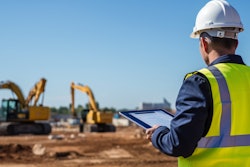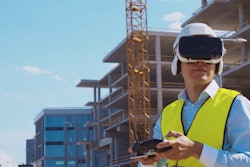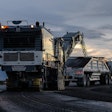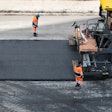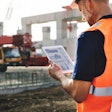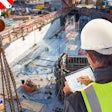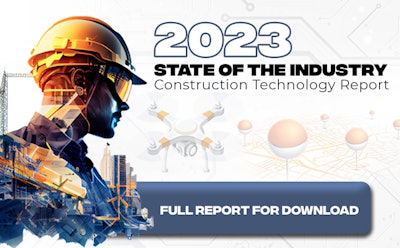
DOWNLOAD THE PDF *Save to your desktop for easy reading & reference
Part I:
IRONPROS Field and Equipment Software Study finds field productivity/ticketing software the most common tech already adopted but GPS Fleet/Asset Management Software will see a substantial investment in years to come.
In this IRONPROS research report, we examine the priorities of contractors when it comes to deploying construction technology in the field. Field Productivity Software was the most significant technology respondents had either currently deployed or were planning and budgeting for. More contractors had in fact already adopted GPS-Enabled Asset Management software, but based on these results, it will soon be eclipsed in its adoption rate by field productivity tools that handle job ticketing, materials and equipment tracking and even time and productivity reporting in the field.
During 2022, IRONPROS surveyed almost 200 construction professionals on their current usage of or plans to use various technologies in the construction industry. These construction technology product categories may have components that are accessed in the back office by administration, managerial and executive staffers, but are designed primarily to extend enterprise software into the field.
This leap has been enabled by mobile technology that leverages smart phones and other devices not only to enable field employees to interact with an application, but to harness phone features like geolocation and cameras. Other specialized devices like wearables and drones may similarly use a mobile device or hardware as much as an Internet of Things (IoT) sensor to monitor production or capture data, providing location-specific context for digital workflows.
The 2022 IRONPROS study addressed this adoption curve and plans to invest in:
Field Productivity/Job Ticketing
GPS-Enabled Fleet/Asset Management
Safety Software/Wearables
Photogrammetry
CMMS/Equipment Maintenance Technology
Looking at where each product is on this adoption curve, we see that:
Usage of two categories, CMMS/Equipment Maintenance Technology and Field Productivity/Job Ticketing could double in size within the next two to three years.
Among the product categories studied, more respondents were in the planning stages on adopting Field Productivity/Job Ticketing at almost 30%.
Photogrammetry is in a statistical dead heat to also double in size, and given advancements in technology now coming to market could rapidly become even more appealing to contractors.
GPS Fleet and Asset Management is the most mature product of those studied, and as the capabilities of these products expand and as vendors make integrations with other enterprise technologies, this technology will become more powerful.
Across all product categories, a fairly consistent percentage of respondents — around 5% — reported formally having budgeted for expenditures.
What is Field Productivity and Job Ticketing Software?
Managing a project from a desk chair is different from managing execution in the field. These construction technologies help assign and ensure completion of work packages on site. These products vary in scope depending on what part of the construction market they are addressing. Some started life as field service management products, designed to manage fleets of technicians and later adding functionality required for project management and assignment of interdependent tasks on a construction site. Others include extensive integration with equipment telematics and can assign, manage and even report both equipment and crew production data.
Related Content
Assignar Grows Field Productivity Footprint on Venture Investment
Sage Field Operations Straddles Field Service and Construction
EquipmentShare T3 Transforms Construction Equipment and Field Operations
Clockshark Offers Widely Applicable Timekeeping
B2W Augments Heavy Construction Estimating with Field Productivity
STACK Field Collaboration Extends Estimating Platform
HCSS Field Productivity Part of Broad Heavy Construction ERP Offering
See Related Products on IRONPROS
What is CMMS (Computerized Maintenance Management)?
Computerized maintenance management software (CMMS) or enterprise asset management (EAM) in construction may refer to software used to manage the built asset after handover as part of a maintenance service contract.
In situations like this, specifically in the case of industrial or productive assets as those in utilities (manufacturing or oil and gas), EAM may be the appropriate term given the executive-level functionality required to help executives balance cost of maintenance and operations against productivity and revenue.
CMMS is the term most often applied to technology that streamlines maintenance activities in a depot or shop environment, and may include tools for spare and repair parts, technician staffing and even support for advanced modalities like condition-based or prescriptive maintenance of construction equipment.
Sample Products
Tenna Is More than Tough
Fleetio Offers Broad Fleet Management for Construction
Asset Panda Expands into Construction
HCSS Equipment360 Part of Broad Construction ERP
See Related Products on IRONPROS
What is Digital Site Survey Hardware?
Products in this category leverage lasers, LIDAR, 360-degree photography, GNSS or GPS signals to capture conditions on a site for a variety of purposes. These include supporting design, engineering or site planning, capturing quantities for estimating, tracking safety compliance or even progress reporting.
See Related Products on IRONPROS
What Are Construction Safety Software and Wearables?
Safety can be a feature of multiple construction software product categories. This construction software leads with safety practice enablement and reporting. Because a construction safety program is dependent on execution in the field to be executed, software used in this space will often collect data through the internet of things (IoT) from a wearable device or other sensors or digital site access points. While these products may primarily focus on communicating safety risks to field crews or tracking and automating safety compliance, some subcategories like robotic exoskeletons may enable an employee to perform work more easily without injury.
Related Content
Smartvid.io
Eyrus Extends Solution for COVID 19
Ricoh THETA 360
Software solutions in this category may involve component parts, such as:
Job Site Security Cameras and Systems
Construction Safety Software
Construction Wearables
What is Construction Photogrammetry?
Photogrammetry is the technological discipline of capturing a 3-dimensional model of reality using photographic images, which in construction is often augmented with a building information model (BIM) or geographic information system (GIS).
Apart from light-based photography, photogrammetry in construction can also harness light detection and ranging (LiDAR), white-light digitizers and other technologies that generate a point cloud—a file containing x, y, z coordinates for discrete points in space. Photogrammetry can also involve creation of digital terrain models based on multiple aerial or satellite images.
Software vendors are now applying machine vision and artificial intelligence (AI) to this data to automate construction workflows including progress reporting.
Related Content:
Propeller Aero Gets Down and Dirty
OpenSpace Extends Progress Reporting
Constru Establishes North American Beachhead
Avvir Augments Photogrammetry Tech with Services
Hyundai Shows Platform Including Hi DETECT
Hexagon AB Acquires Avvir
SiteAware Uses Series B to Extend Solution
StructionSite (now owned by DroneDeploy) Customer Part of Investment Round
Read our IRONPROS Photogrammetry Wiki to Learn More and See Related Products
Part 2:
In this research report, we examine the priorities of contractors when it comes to deploying technology on production and field equipment. GPS Asset Tracking Hardware comes in at the top of the list in terms of technologies contractors are using or planning/budgeting for. Here, we look at all of the top categories and key vendors in each category.
During 2022, IRONPROS surveyed almost 200 construction professionals on their current usage of or plans to use various digital technologies integrated with field-based construction equipment and assets. These construction technology product categories may have components that integrate with other technologies used by management-level professionals but are primarily aimed at collecting data from or automating operation of production equipment.
The product category respondents reported using, planning or budgeting for most frequently was GPS Asset Tracking Hardware. The category most respondents said they were planning or budgeting for was collision avoidance technology.
What is GPS Tracking Hardware?
Construction fleet management often relies on sensors and GNSS units on equipment. This is the hardware used to capture and relay data to support construction operations. Paired with GPS-Enabled Asset Management Software, this hardware can relay operating information from the machine to systems that record duty cycles, report work performed and administer maintenance activities.
Some of this hardware is cross-industry, while in other cases, vendors will create devices designed specifically for construction equipment. This specialized equipment may be distinguished by ruggedized design or unique fit and function.
What Is Collision Avoidance?
Using various reality capture tools including light-based cameras, LIDAR and SONAR paired with machine vision technology, technologies are coming to market either in OEM equipment or as aftermarket components to prevent equipment from hitting objects and more importantly pedestrians.
Related Content
How AI Machine Learning Prevents Skid Steer Injuries, Deaths
AI Technologies to Reduce Construction Risk
New Tech Limits Job Site Collision Risks
Excavator Automation Reaches Next Level
What Is OEM & Third Party Telematics?
Telematics hardware and firmware is part of many equipment products shipped from OEMs. These technologies are becoming more open thanks in large part to the ISO 15143-3 standard pioneered by the Association of Equipment Management Professionals (AEMP).
But in some cases, telematics from OEMs are advancing further as networks of suppliers supplement the standard data set with additional engine- or equipment-specific data to support predictive or prognostic maintenance where data from multiple components can just be factored into a recommendation or diagnosis.
Some telematics units and firmware are installed aftermarket, and may support maintenance, automation or other applications used to manage or operate the equipment. In other cases, these telematics units are primarily aimed at data collection, often on pieces of equipment that are not typically equipped with telematics hardware from the OEM.
Related Content
VIDEO: Mind-Blowing Future of Telematics
Telematics Go Beyond Fleet Management
Telematics Reaches into Lift Equipment
VIDEO: Smart Trailers and Video Telematics
What Is OEM & Aftermarket Machine Control?
Technology to automate operation of construction equipment is coming both from the OEM as a stock feature or as an aftermarket option sold by third parties. Oftentimes, OEM machine control is provided by third party technology vendors who may partner with the OEM to include their hardware and firmware on a new product. Aftermarket machine control also often involves the OEM who may pre-install brackets and other features to facilitate its addition by a technology partner.
Related Content
Construction Robotics vs Automation
Trimble Machine Control at BAUMA
Hyundai Shows Technology Infrastructure Platform Including Hi ASSIST
3 Emerging Equipment Automation and Guidance Systems
Tiny Mobile Robots Grows on Influx of Capital
Autodesk University includes Robotics Announcements
Cat Command Ushers in New Era of Remote Operation
Trimble Machine Control for Paving, Pile Driving, Drilling
Dusty Robotics Scales Digital Floorplan Printing Product Offering
Florida Bridge Contractor Automates Rebar Tying
Robots Simplify Parking Lot Striping
Construction Equipment Machine Control Transforms Jobsite Intelligence
See Robotics Products on IRONPROS
What Are Job Site Security Cameras?
These are the cameras used on construction sites which can prevent equipment and material loss to theft. Some of these cameras double for other site data capture chores too.
See Related Products on IRONPROS
Part 3:
Artificial intelligence (AI), the Internet of Things (IoT), augmented/virtual reality (AR/ VR) and interconnected equipment will change construction forever, as they have already changed other more tech-forward industries. But when? Here, we look at adoption patterns and plans for these technologies. We also suggest respondents may be further along in adoption of some of these technologies than they think.
During 2022, IRONPROS surveyed almost 200 construction professionals on their current usage of or plans to use various digital technologies integrated with field-based construction equipment and assets. These construction technology product categories may have components that integrate with other technologies used by management-level professionals, but are primarily aimed at collecting data from or automating operation of production equipment.
The product category respondents reported using, planning or budgeting for most frequently was GPS Asset Tracking Hardware. The category most respondents said they were planning or budgeting for was collision avoidance technology.
Interconnected Equipment
Based on the percentage of respondents who had adopted or saw technology as important in the next 10 years, interconnected equipment was the single most significant technology studied. This was driven by a slight lead over some other categories in respondents already using the technology, but significantly percentages say interconnected equipment will be important in either five or 10 years. Interconnected equipment, which involves digitally mediated coordination between pieces of equipment engaged in a project is a critical way for autonomous digital processes to come to market in equipment-centric construction.
We have seen this trend manifest already in repetitive construction settings like roadbuilding, where digital coordination between automated pavers, compactors and even material trucks result in a smoother, more reliable linear asset by eliminating stops caused by interruptions in the process.
As more equipment comes to market with or is augmented with aftermarket robotic features, these pieces of equipment can be coordinated based on real-time production information and reality capture from the field. This will improve quality, cut down on the operating engineer and managerial workloads and potentially speed up the work-in-progress phase of projects. In this fashion, lean business process and efficiency improvements can come to construction through automation.
Augmented/Virtual Reality Training
Augmented and virtual reality tools designed as training aids for equipment and field situations have been in market for a while. These products are mostly tightly aligned with specific classes of equipment, and training may even be designed around a specific make or model.
Sensors/Internet of Things, Artificial Intelligence
While the internet of things (IoT) and related sensors and artificial intelligence were far back in the pack of technologies, AI and IoT are already coming to market in ways that may not be immediately apparent to respondents and other contractors. AI, in particular, brought up the rear in this study with 35 percent of respondents saying it is not important and only seven percent reporting they use it now, but if contractors dig below the surface, they will often find AI features hard at work in their equipment, front-end and back-end systems. IoT similarly underpins most contractors’ telematics programs. Equipment automation is also driven by one or both of these technologies.
IRONPROS is tracking the use of AI to support things like machine vision for equipment automation, features coming to construction software to, for instance, automate scheduling or optimize selection of projects to bid.
Related Content
Cat Command Ushers in a New Era of Construction
VIDEO: Construction Robotics and Automation
VIDEO: The Future of Construction Telematics
VIDEO: Smart Trailers and Telematics
VIDEO: Trimble and Hilti Launch Connected Hand Tool Partnership
Trimble Show Machine Control at BAUMA
Grade Control Makes It Rain for This Contractor
Constrafor Uses AI in Financial Automation Offering
Equipment Rental Software Delivers Availability Data Through AI
Three AI Technologies for Project Risk Mitigation
AI Boosts Warfel’s Safety Protocol
Estimating Software Trends Include AI
Zetane Leverages AI for Estimating
Part 4:
In this IRONPROS research report, we examine the degree to which younger professionals entering the construction industry will drive adoption of transformational technologies including:
Artificial Intelligence (AI)
Internet of Things (IoT)
Augmented/Virtual Reality
Connected Equipment
Autonomous Equipment
Multiple construction experts, journalists and vendors have posited that while the construction industry has been slow to adopt these technologies when compared to other industrial sectors, technology could be helpful in attracting younger workers.
Some have also posited that more complete adoption of these technologies across various industries may be helped along by these same younger workers. One 2019 report from the Committee for European Construction Equipment describes this “chicken and egg” problem where younger people are more accepting of technology, but technology will be helpful for recruiting younger workers:
“From the interviews it emerges that the construction sector suffers from a ‘generational issue.’ Older workers, who have developed a strong expertise and knowledge, represent the majority of the construction workforce (in the US the average age of construction workers has increased by seven years between 1985 and 2014 and the trend is similar in EU countries as stated in the European Construction Sector Observatory reports). However, they tend to be less open to the adoption of digital technologies. While the average age of construction workers has been constantly increasing and in many cases retirement age is approaching, it is not been coupled with an increased presence of younger generations. Young people still consider the construction sector as ‘dirty, dangerous and demeaning.’ This is also one of the reasons why the number of women in the sector tends to be much lower than their male counterparts.”
During 2022, IRONPROS surveyed almost 200 construction professionals on their current usage of or plans to use various equipment and field technologies, as well as their opinions of how important transformational technologies will be in coming years.
Respondents Were Asked:
Artificial intelligence technologies that help make decisions: Which of the following transformational technologies are already embedded in your equipment or software and which do you see as becoming important in the future?
Respondents Answered:
Sensors that relay data for decision support, analysis or to trigger actions
Augmented or virtual reality for safety training or project visualization
Real-time information sharing between all machines on the job site
For each transformational technology, IRONPROS asked if respondents were using that technology now, whether it would be important in the next five years, in the next 10 years or would not be important at all. By cross-tabulating a demographic question on respondent's age with this question, IRONPROS was able to determine to what extent younger people see potential in these transformational technologies when compared to older professionals.
Takeaways from this Exercise Include:
The number of respondents in the youngest age group of 18-25 was a tiny minority, which suggests that among the AC Business Media construction audience, they are under-represented in this sector.
While the number of 18-25-year-olds was small, those in the study were less likely to see the potential of these technologies than respondents at the older end of the age range.
While 100 percent of the 18-25-year-old segment said their company was already using or saw potential for interconnected equipment, this represents a handful of individuals out of the study and may be the topic for further research with a larger sample of younger construction professionals.
While digital natives may be fluent users of consumer technologies, understanding how technology may be applied to business problems is the purview of more senior professionals, managers and executives who tend to be older.
The age demographic most likely to see potential; in each of these transformational technologies, apart from the 100 percent score for connected equipment among 18-25-year-olds, were respondents age 46-55.
Among respondents indicating they worked in corporate management; 87 percent were older than 46. These are the individuals charged with taking construction businesses into the 21st Century, and while many would not be considered “digital natives,” they will have the business acumen to align processes and technologies and will be the ones held accountable for the success or failure.
Related Content
Owners Push Contractors Towards Digital Intercompany Workflows
2023 New Years Resolutions for the Construction Industry
Changing the Conversation Around Construction Careers to Lure Labor
4 Factors Delaying Digital Transformation in Construction
Aging Workers Drive Construction Labor Gap
----
**Click on the following photo to download and save the 2023 State of the Industry: Construction Technology Report

